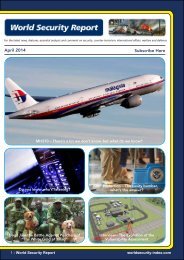World Security Report Jan 2015
World Security Report is a prime source of online information and analysis on security, counter-terrorism, international affairs and defence
World Security Report is a prime source of online information and analysis on security, counter-terrorism, international affairs and defence
You also want an ePaper? Increase the reach of your titles
YUMPU automatically turns print PDFs into web optimized ePapers that Google loves.
BORDER SECURITY<br />
Billions in losses<br />
The indirect effect is important<br />
to consider because the war<br />
disrupted the intra-Levant trade,<br />
which grew seven-fold between<br />
the early and late parts of the<br />
2000s. It put an end to plans for<br />
deepening intra-regional trade ties<br />
further following the signing of the<br />
“Levant Quartet” agreement in<br />
2010. The benefits of deep trade<br />
integration reforms were expected<br />
to be sizable.<br />
Areas affected An estimated 9<br />
million Syrians have fled their<br />
homes since the outbreak of<br />
civil war in March 2011, taking<br />
refuge in neighbouring countries<br />
or within Syria itself. According<br />
to the United Nations High<br />
Commissioner for Refugees<br />
(UNHCR), over 3 million have fled<br />
to Syria’s immediate neighbours<br />
Turkey, Lebanon, Jordan and Iraq.<br />
6.5 million are internally displaced<br />
within Syria. Meanwhile, under<br />
150,000 Syrians have declared<br />
asylum in the European Union,<br />
while member states have<br />
pledged to resettle a further<br />
33,000 Syrians. The vast majority<br />
of these resettlement spots –<br />
28,500 or 85% – are pledged by<br />
Germany.<br />
While it is true<br />
that the EU<br />
is a leading<br />
contributor of<br />
humanitarian aid<br />
to the region,<br />
the amount<br />
donated by each<br />
of its 28 member<br />
states has<br />
varied greatly.<br />
Furthermore,<br />
while the EU has accepted the<br />
vast majority of Syrians who have<br />
applied for asylum, it has to date<br />
received relatively few requests.<br />
Its response to a UNHCR call for<br />
more than 130,000 resettlement<br />
spots for Syrian refugees between<br />
2013-2016 has also been tepid.<br />
In contrast, absorbing the influx of<br />
refugees has been an enormous<br />
challenge for Syria’s neighbours,<br />
with strong implications for the<br />
stability of the entire region.<br />
The effect on Lebanon provides a<br />
good example of the infrastructure<br />
challenges faced by other nations.<br />
Geography of Lebanon<br />
Lebanon is located in Western Asia<br />
between latitudes 33° and 35° N<br />
and longitudes 35° and 37° E.<br />
The country’s surface area is<br />
10,452 square kilometres (4,036<br />
sq mi) of which 10,230 square<br />
kilometres (3,950 sq mi) is land.<br />
Lebanon has a coastline and<br />
border of 225 kilometres (140 mi)<br />
on the Mediterranean sea to the<br />
west, a 375 kilometres (233 mi)<br />
border shared with Syria to the<br />
north and east and a 79 kilometres<br />
(49 mi) long border with Israel to<br />
the south. The border with the<br />
Israeli-occupied Golan Heights is<br />
disputed by Lebanon in a small<br />
area called Shebaa Farms]<br />
Lebanon is divided into four<br />
distinct physiographic regions:<br />
the coastal plain, the Lebanon<br />
mountain range, the Beqaa valley<br />
and the Anti-Lebanon mountains.<br />
Lebanon<br />
Lebanon is currently on the front<br />
line of the fight againt ISIS.<br />
Lebanon is the second largest<br />
recipient of US military aid in the<br />
middle East outside of Israel and<br />
is also partnering with the UK<br />
14 - <strong>World</strong> <strong>Security</strong> <strong>Report</strong> www.worldsecurity-index.com













